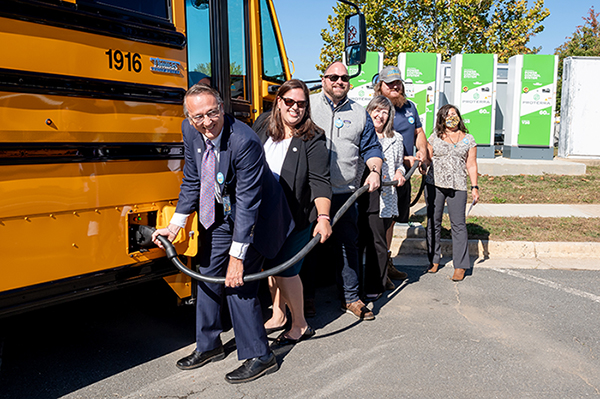New education reform arrives
After more than a decade, “No Child Left Behind” act, ratified in 2001, is being updated. The new and improved “Every Student Succeeds” act promises to reduce the federal government’s role in public education, and place more responsibility into the hands of local and state governments. To quote a statement released by the White House, the new legislation “rejects the overuse of standardized tests and one-size-fits-all mandates on schools.” While day-to-day operations of schools across the nation will remain the same, the role and scope of Standardized testing is being overhauled.
Standard(ized) Fare
At this point, it is reasonable to assume that most Annandale students have been taking standardized tests for their entire educational career. The spring months of every school year have long been characterized by long review sessions and seemingly endless busywork. Though some students may have found this work to be tedious and useless, it served an important role in keeping Annandale safe from government action outlined by the No Child Left Behind act.
No Child Left Behind was signed in to law to address America’s growing achievement gap between students of different socioeconomic statuses. According to the Washington Post, many schools were simply failing to teach their more impoverished students. The law introduced yearly standardized testing, and threatened harsh federal intervention against schools that failed to meet “adequate yearly progress,” essentially a target pass/fail rate. Funding could be cut, staff members could be fired, or the school could be forced to completely restructure its administration and curriculum. According to a teacher interviewed by the NPR, the No Child Left Behind act was essentially a “sledgehammer,” one that punished schools that could not achieve certain pass rates in reading and mathematics, without paying any attention to the school’s special circumstances. An impoverished inner city school would be held to the same standards as a public school located in a wealthy suburb, and schools that were already suffering only deteriorated further under federal oversight. In many cases, No Child Left Behind punished the low-income students and schools it sought to protect.
According to NPR, former president George W. Bush promised that No Child Left Behind would be directed towards “methods that actually work.” Despite the former president’s assurances back in 2001, the impact No Child Left Behind has had a mixed impact.
Globally, the USA’s education system ranks 14th in the world according to a 2014 Pearson study, one rank below Russia. While possessing the 14th best education system in the world is no small accomplishment, the United States could also be doing much better. Countries with smaller economies and populations, such as Finland (5th) and Ireland (9th) are doing considerably better despite having less resources to work with.
While it may be tempting to simply blame the USA’s ranking on an overuse of standardized testing, it is worth noting that South Korea and Japan, two countries infamous for their heavy use of standardized testing, occupy the two highest ranks on Pearson’s list, with Korea’s education system being the best in the world by Pearson’s metrics. The problem is not just standardized testing.
Leaving Behind No Child Left Behind
As of December 10th, 2015, No Child Left Behind is no longer in effect. It has been replaced by the Every Student Succeeds act, a law aimed at maintaining standardized testing requirements, while also putting more power in the hands of state and local governments.
According to the National Education Association, standardized testing will be required annually through grades 3-8, and once during high school. That said, there is no federally defined pass/fail rate like what was seen with No Child Left Behind’s “adequate yearly progress” mandate. Every Student Succeeds will also provide funding to states in order to improve their standardized tests.
In the classroom, teachers will no longer be subject to mandatory federal evaluations, and puts more decision making power in the hands of the teachers and parents. According to the Washington post, assisting struggling teachers or students is now the responsibility of the state governments and local school systems, instead of the federal government.
Finally, the Federal government has stated that it will work with state governments to “establish or expand access to high-quality, state-funded preschool for children from low- and moderate-income families.” This measure has been praised by the National Education Association, amongst other organizations, since studies have shown that providing a quality education to children before they turn five can have “significant long term benefits.” The benefits of a quality preschool education are not only cognitive. Another study conducted by Highscope has shown that a child who receives a preschool education will earn $2,000 more per month later in life than a child who does not receive a preschool education.
What AHS Students can expect
As previously mentioned, the Every Student Succeeds act will not have a large impact on the day-to-day operations of schools across the country. Students will still be on the same SOL testing regiment. The main difference will be how standardized testing scores will be used. Instead of being subject to federal guidelines, AHS and other FPCS schools will ultimately answer to the state government regarding their standardized testing scores.
Most of the new rules and guidelines are at an administrative level. Students can still expect to take their SOLs at the end of the year, but can take comfort in the fact that their scores will subjected to more reasonable requirements.

Nicholas Mortensen is a senior at Annandale High School and is a first-year staff writer at the A-Blast. Nicholas is an IB Diploma candidate, and is a...







